By Jeffrey A. Rendall, Photos By Jeffrey A. Rendall
BISHOPVILLE, MD -- 'They just don't make 'em like that anymore.' It's something you might hear from some kindly old octogenarian when reminiscing about cars back in the forties, or even from your mother when talking about the quality of potential mates these days.
But in the case of The Links At Lighthouse Sound, near Ocean City on the Maryland shore, the statement certainly applies in a contemporary sense. In fact, Lighthouse Sound's Head Golf Professional, Dennis Winters, all but put it in the same terms: "Our golf course rests on over a thousand acres here, so we really offer that spread-out feeling at our facility. The first seven holes play along the Assawoman Bay and St. Martin's River, including holes four, five & six, which are basically looking directly at the Ocean City skyline. It's a very unique view -- no other golf course in the area has it."
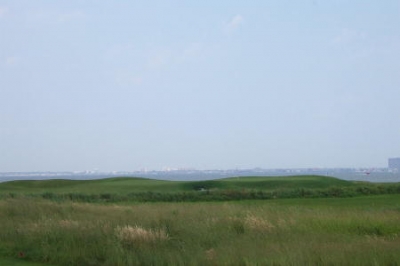 |
| Something you won't see every day, but quite a lot of at Lighthouse Sound -- Stunning views of the bay, the Ocean City Skyline, and lots of wetlands. Here, looking towards the 5th green. |
He continues, "Then, when you head towards the back side, the routing becomes more of a woodland type golf course. So it's really the best of both worlds -- a links-style outward side that plays along the bay, then a wooded inward side that plays through stands of hardwoods, wetlands and the St. Martin's River."
There's more: "And what's nice, on the back nine, you don't see any homes. You may see some other golfers, but you're basically out there with the elements. Putting the whole of this place together, with the ocean views and vast expanses of marshlands, it's pretty special. For this type of golf course to be built so close to a protected wetland area is unheard of these days -- they just don't make 'em like this anymore," proclaimed Winters.
The Links At Lighthouse Sound opened in May of 2000, an Arthur Hills design that instantly drew considerable attention from major publications (Top 10 New 'Places You Can Play' in the United States by Golf Magazine), due to its links-like qualities, stunning bayside sights and dramatic playing characteristics. Lighthouse now resides comfortably in Golf Digest's annual lists of the best courses in Maryland, as well as garnering much additional recognition from just about every publication that takes the time to rank golf layouts.
It was all part of the plan for owner Tom Ruark, who saw an opportunity, then jumped on it. "There was a gentleman a few years back who wanted to develop this property as a golf course," Winters explained. "I'm not sure exactly what happened, but apparently he was filling in some areas that he wasn't supposed to be, and the Department of Natural Resources stepped in and put a stop to the operation. Then some other groups tried to come in to finish the project, only to fall short -- something wasn't in place, the financing, etc..."
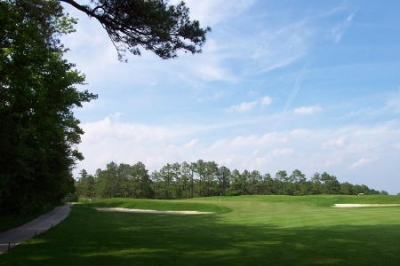 |
| The back nine is more wooded, but the scenery's just as attractive. Here, glancing from the fairway to the 14th green. |
"Finally, Mr. Ruark came along, and pretty much took the bull by the horns, and now we have this incredible golf facility," Winters said proudly.
That's no overstatement. As Winters said above, Lighthouse Sound really is unique to this region. He compared it to the Ocean Course at Kiawah Island off the South Carolina coast (which hosted the Ryder Cup matches in 1991), and having never actually laid eyes on that famous set of seaside holes, I can't say for sure one way or the other. But one thing is certain, the experience you'll get along this piece of Maryland shore isn't something you'll see everyday.
Arthur Hills, the brain behind The Links, thinks so, too: "Tom Ruark got a hold of what I'd say is an exceptionally dramatic piece of property, which provided the basis for putting together a golf course that's really been well received."
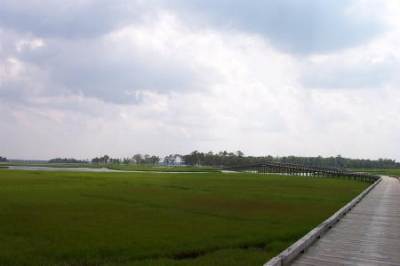 |
| This lengthy cart bridge joins the two halves of the golf course. |
"There is a residential component in the middle of the front nine, but Ruark afforded us the opportunity to build all the perimeter holes along the edge of the savannahs and intercoastal waterway there. Essentially, he gave us the best property for the development of the golf holes, and the results show," Hills added.
Hills is quite the modest, soft-spoken gentleman, and for him to speak of Lighthouse Sound in such glowing terms indicates his enthusiasm for the product there. But as Benjamin Franklin once hypothesized, there can be no gains, without pains: "It wasn't exactly the easiest course to build, but one of the nice things about it was the fact we really didn't have a lot of trouble with getting environmental permits. That may sound odd, considering the waterfront property that the course sits on, but particularly on the front nine, we were all on 'up' land (much of the front nine was formerly farmland, complete with silo). We were cautious to make sure that we weren't draining into the Bay, putting fertilizers and stuff into it. But I think we had a pretty carefully organized concept that didn't disturb any of the wetland edge."
Echoing Winters' earlier sentiments, I'd say the course plays similarly to the golf layouts farther south along the coasts of South Carolina and Georgia -- mainly because there are few parallel holes, with the balance bordering some sort of natural trouble. You'd better find a way to hit a straight ball here, or better yet, command the movement on the little white sphere. It was particularly helpful to plot a way through the course using the yardage book, which is an essential piece of hardware on this target-oriented layout (the carts also have a GPS system for those more electronically inclined).
But just because you see and understand the preferred course, it's still a physical challenge to execute it (or, another thing moms used to say, 'Seein' ain't gettin''). Winters acknowledges the difficulty: "When Mr. Ruark decided to put a golf course here, he talked about what he wanted with Mr. Hills. Ruark wanted a difficult course, and said 'I want it tough. I want people to know when they leave here, they can say that this was a tough golf course' -- and Mr. Hills complied."
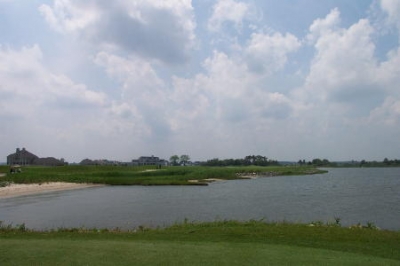 |
| On the 6th tee, you know you have to clear the water and put it in play. Hardly impossible, but still quite a challenge. |
One aspect of the difficulty is the elevated greens at Lighthouse. Even on the relatively flat and treeless links-style holes, you'll still need to negotiate some slight rises to place the ball on the putting surfaces. Again, Winters expounds: "Pretty much all the greens are elevated, with different slopes, elevations and undulations. Some of 'em have tiers. So, pin positioning on the greens is a must, as far as club selection -- and with the sizes of the greens, it can be the difference of two to three clubs. Then you've also got the wind."
Never forget the prevailing breeze, because it'll whip through your curly locks (if indeed you've got them) with a vengeance on the bayside holes. Particularly on the par three fifth hole, which measures up to 218 yards, you'll feel the brunt of nature's fury. Hills said it's probably one of the toughest par threes on the east coast, because the green's only 18 yards deep. Standing on the tee, you'll basically see a bump with a flagstick and the Ocean City skyline in the background. It's up to you to determine what's the bigger target.
There's also a commitment to excellence at Lighthouse Sound, which shows in both the conditioning and service at the facility. "We're very proud to have Mr. Paul Latshaw Sr. as our head of agronomy at all our facilities," remarked Winters. "He was formerly the head greens superintendent at Augusta National, but he was also at Congressional, Riviera, Oakmont, Merion and Winged Foot. He's the Tiger Woods of greens superintendents."
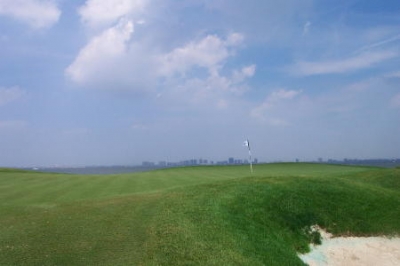 |
| Once you've reached dry land on the par three 5th hole, then you can appreciate the views of Ocean City. |
Wow, talk about name-dropping.
When we visited the course (early summer of 2003), the region was just finishing up an incredibly cool and wet spring. The conditioning was up to the level you'd expect from a club in this price-range, yet will probably be even better in more hospitable weather patterns. And with Mr. Latshaw's oversight, that's a guarantee (Eric Snelsire is the full-time superintendent, who Mr. Latshaw brought from Oakmont Country Club).
Then there's the service element. Most high-end clubs tout service to their guests. But at a Ruark Golf facility, it's more than mere boasting: "One thing a lot of people notice on their visits is the number of 'Player's Assistants' we have out here. We have two on each side, not only policing pace-of-play, but helping players with the aspects of the game that might sometimes slow people up, like spotting shots and raking bunkers," Winters added.
"If a group falls behind, we'll let 'em know it. But when they catch up to the position they're supposed to be in, we'll thank them afterwards for it. I think that sets us apart from most other golf operations, because our pace-of-play policy is more than just going out there and telling people to 'hurry up,'" said Winters.
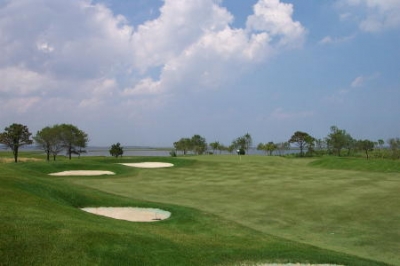 |
| Nearing the green on the 622 yard, par five 7th hole. You might have thought you'd never get there. |
Not that you'll want to hurry here. Hole highlights include the bayside stretch that Winters mentioned above, namely holes four, five, six and seven. Four is a brutish, risk-reward 430 yard par four that carries the #3 handicap label. Five is the par three referred to above, a virtual island surrounded by wetlands, tall grasses and water (though the wet stuff doesn't really come into play). Six is a 390 yard par four that plays along the bay, and depending on the wind can offer a reasonable chance at birdie or a gut-wrenching challenge to try and make par.
Seven is one of the more interesting par fives you'll ever see. From the back tee box, it's a 240-yard carry over wetlands to reach the fairway. Hills describes it: "That back tee on seven is just about impossible, depending on the wind. I think you've got to be Tiger Woods or something to get it over that." Once you've found the fairway, you'll need to choose where to lay-up on this 622 yard, three-shot monster -- either short of a creek, or long and left of it. From personal experience, it's a much easier third shot from the long side.
The back 'nine' actually includes ten holes, since the #1 handicapped ninth hole is on that side, across the quarter-mile long cart bridge (complete with turn-outs for two-way traffic). As is alluded to above, the back side plays along woods, wetlands and some water hazards. Continuing on the overall theme, you'll need both length and accuracy to mark down good scores.
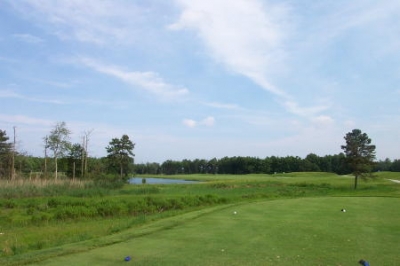 |
| Risk-reward all the way on the par four 15th hole. Cut off as much of the leg as you dare. |
It should be noted that Lighthouse Sound's back tees play just over 7000 yards (7031), but command a well-deserved slope of 144. But as Hills says, the response to the course has been overwhelmingly positive. "I guess that means players like challenge," Hills figured.
That's true. There's satisfaction in making a good score on this layout. It also shows, they really can make 'em 'like that' again, just like the old days.
Where To Stay
Seeing as this was our first trip to Ocean City, we wanted a place that was family friendly, convenient to the golf courses, apart from the 'heavy' party areas of the city, and affordable, to boot. We found what we were looking for at the Comfort Inn Gold Coast, located at 11201 Coastal Highway in Ocean City. The Comfort Inn Gold Coast provides access to the beach without paying beachfront prices -- and offers a very pleasant trip to the shore without a lot of frills, hassles or bills. And even better, it also offers packages to visiting folks hitting the links. Golf Package Hotel Accommodations include: 2 double beds; microwave oven; refrigerator; wet bar; coffee maker; cable TV; indoor heated pool and Jacuzzi; a Denny's 24 hour restaurant; first floor guest laundry facilities; 24 hour lobby convenience store; grocery store, pharmacy & beer, wine & liquor store nearby; and meeting rooms for hospitality and social gatherings.
A stay at the Comfort Inn Gold Coast can be combined with all the excellent golf courses in the area, and package prices vary throughout the season, ranging from $105 - $249 for weekday (Monday to Thursday) stays, and $139 - $295 for weekend visits. Rates are per person, double occupancy required, based on availability. Single rates are subject to surcharges, and Golf Widow packages are available! These folks also pride themselves on customizing golf packages.
For information, or to book a package, call the sales department at (410) 524-3000. To contact Choice Hotels, call toll free 1-800-228-5150. Or, visit them on the web at www.comfortgoldcoast.com.
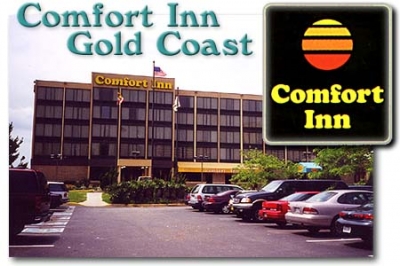 |
Where to Eat
Though we'll hardly be able to provide a complete rundown of local eateries (or even an adequate one, for that matter), we're happy to recommend PizzaTugos. We wanted to try a 'local' pizza joint in Ocean City, and it doesn't get any better than PizzaTugos -- and they're open practically all night, too -- perfect for those early morning beer, poker and cigar parties.
Details:
The Links At Lighthouse Sound
12723 St. Martin's Neck Road
Bishopville, MD 21813
Phone: (410) 352-5767
Toll Free: (888) 55-HILLS
Website: www.lighthousesound.com
Read also about another Ruark property, Rum Pointe.
Course Designer: Arthur Hills
Head Golf Professional: Dennis Winters
Head of Agronomy: Paul Latshaw Sr.
Course Superintendent: Eric Snelsire
| Tees | Yardage/Slope | Rating |
| Black | 7031/144 | 73.3 |
| Gold | 6556/138 | 71.1 |
| Blue | 6041/126 | 68.3 |
| White | 5548/120 - 137 (L) | 66.0 - 73.7 (L) |
| Red | 4553/107 | 67.1 |
Rates:
During peak times (spring and fall): Mon-Thur, $120 plus tax; Fri-Sun, $140 plus tax.
Summer months (last week of June through the first week of September): $130 for both weekday and weekend, prior to 1:00 p.m. After 1:00 p.m., the rate is reduced to $89. After 4:00 p.m., the twilight rate goes to $49.
Rates includes range balls and carts (with GPS system). Walking is allowed (during certain times), but it's tough to do, with the lengthy cart bridges.
Lighthouse Sound works with Ocean City Golf Getaway and Pam's Golf Packages (We booked through Ocean City Golf Getaway and found it very satisfactory. The telephone number is 1-800-4OC-GOLF). Lighthouse Sound also includes a gift pack, complete with yardage book and a ball repair tool for the greens.
| Related Links | Comments on this article? | |
|
Maryland National Golf Club Hollow Creek Golf Club Rocky Gap Resort PB Dye Golf Club in Ijamsville Whiskey Creek Golf Club |
E-mail Jeff Rendall, Editor: jrendall@golftheunitedstates.com |












